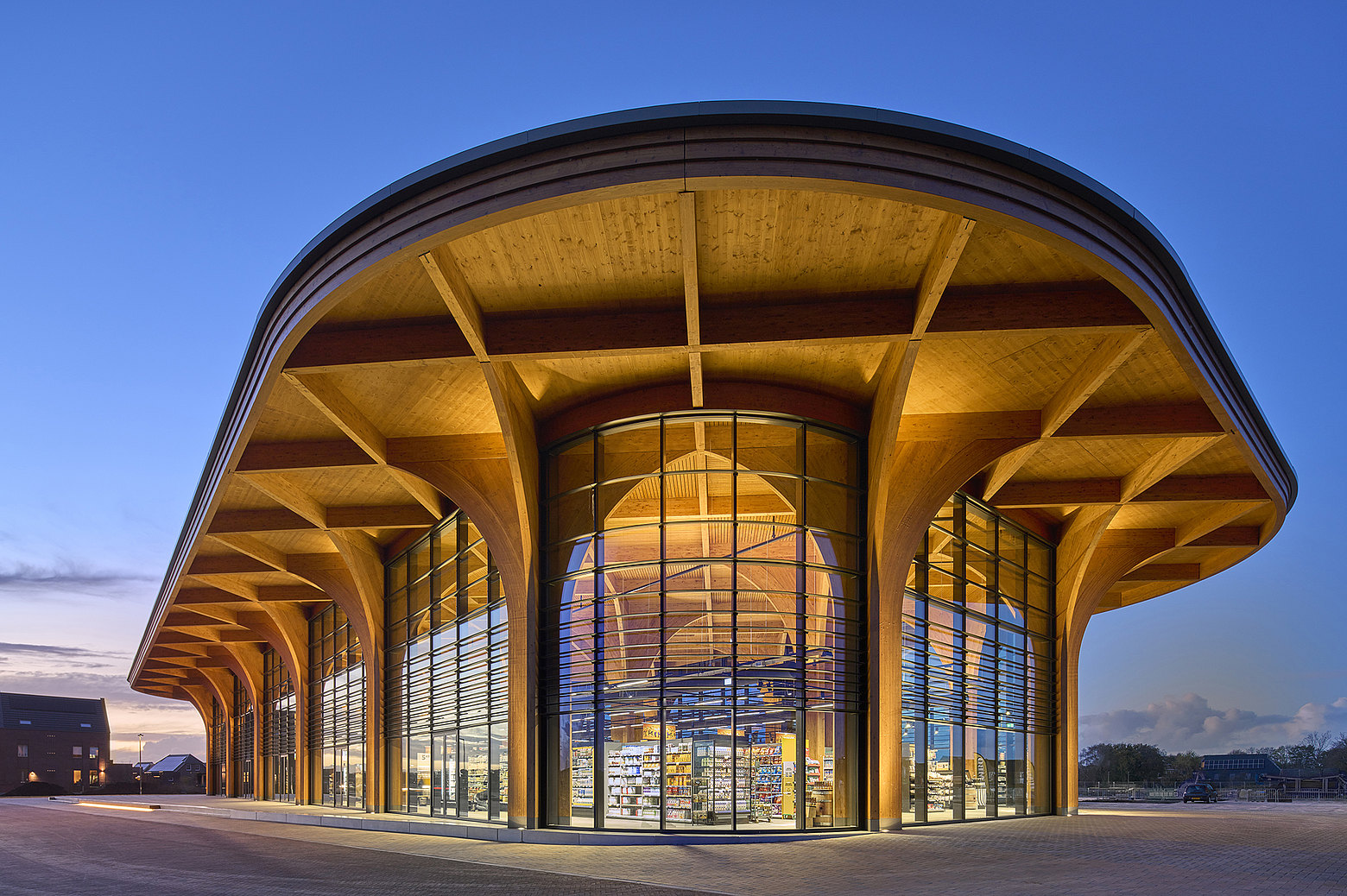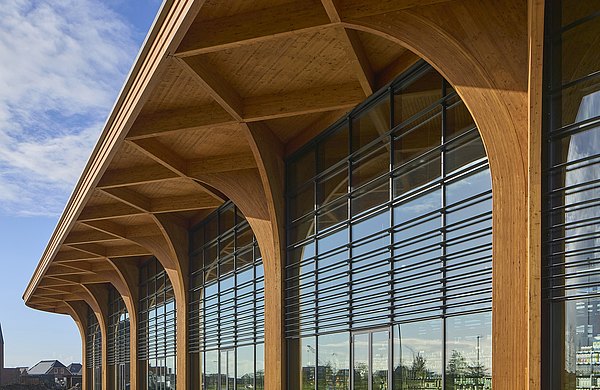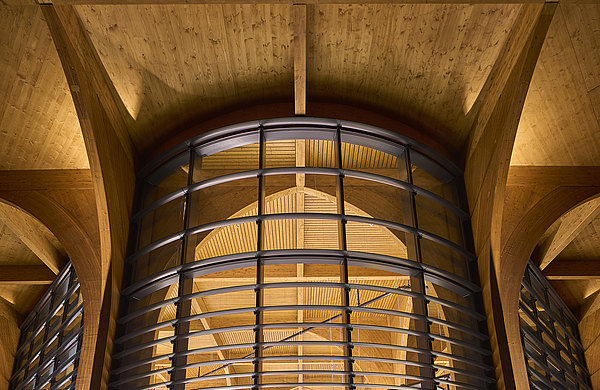SuperHub Meerstad
A multifunctional market hall
Meerstad is a modern planned town located in the eastern suburbs of Groningen in the Netherlands – an up-and-coming district situated in the heart of the countryside. The town is currently undergoing the gradual development of around 5,000 new homes around the freshly dug lake Woldmeer. Until recently, the town was still lacking an urban centre. This is where the design studio for architecture, urban planning and strategy, De Zwarte Hond, came in. The studio took the first step to securing the town’s urban nucleus by designing and building a SuperHub, which aims to function not only as unique place for shopping, but also as a social hub. The facade of the spectacular oval wooden construction was created using the forster thermfix vario modular profile system, which works perfectly with the contoured wooden support structure of the building and offers Passive House-standard thermal insulation.
The way in which we shop is undergoing radical change, resulting in an ever-increasing number of traditional department stores having to close their doors. For shopping centres to be future-resilient, they need to be both flexible and hybrid, and offer a high-quality experience so as to create a space where visitors will want to spend their time. With a footprint of around 2,000 square metres, the SuperHub in Meerstad is a modern re-interpretation of the traditional market hall, offering multifunctionality as well as the potential to be adapted to future uses.
Modern market hall with a wide range of potential uses
In addition to a supermarket, the SuperHub currently accommodates a café and a health centre. In the future, it may also become home to a community centre, events venues or even flats. This means that the SuperHub constitutes a future-proof town centre, which will continue to grow and develop alongside the Dutch planned town of Meerstad. There are already spacious areas for people to meet up and chat, which transform the concept of shopping into a social and personal experience and provide an exciting alternative to delivery services and online shopping.
Sustainable architecture using wood, glass and steel
The impressive oval building with its transparent architecture is based on a construction of cross-shaped, cross-laminated timber pillars and a steel facade, and resembles a modern cathedral. The combination of wood and steel – two very distinctive, yet complementary materials – is visible both from the outside and the inside. The project’s lead architect, Erik Roerdink, explained that the use of steel meant that no auxiliary structures were required, enabling the massive steel facades to appear even more transparent. This creates a beautiful symbiosis between the internal and external space, and encourages people to use the SuperHub as a social meeting point. The porch – which extends more than five metres – provides a covered outside space and integrates the main body of the building into the surrounding parklands.
For the curtain wall, the forster thermfix vario system was used, in the 60 x 250 x 5 mm format, with a span of around 8.8 metres and heat-insulating triple glazing. Erik Roerdink commented that this decision was based on the knowledge that, in order to match the remarkable shape and design of the SuperHub, large, curved windows were required that would fit the curved facade. “Forster had previous experience with projects of this scale and therefore had the right profiles for such large spans" added the architect. "They supplied excellent and precise systems, which could be assembled relatively quickly and easily, allowing us to keep to the agreed project completion date for the SuperHub.”
As for the double doors, it was the robust forster unico system that was chosen. This system is characterised by its long service life, offers excellent thermal insulation and has contact-free opening. This makes for the perfect doors for supermarkets and other buildings with a high usage frequency.
Ecological and pioneering
By making flexibility a key component of the building and thus allowing it to be repurposed in the future, the building will be able to grow with the district and meet ever-changing needs whilst conserving resources. The sustainable design with wood and steel also helps to minimise the building’s environmental impact. The roof offers space for a photovoltaic system and ecologically valuable greenery, whilst the built-in ventilation system and heat and cold storage system in the ground ensure an optimum internal temperature. The window and fixed glazing profile systems installed on the building also contribute to its long service life and sustainability. The forster thermfix vario system uses no synthetic insulating materials and is made from 100% recyclable steel, making the solution particularly sustainable.
Building with the resource-conserving and energy-efficient steel systems from Forster allows companies to guarantee a high level of sustainability and to demonstrate responsibility with regard to the environment and future generations. These systems help reduce buildings’ energy consumption and lower heating and cooling costs.
Groningen, Netherlands
Products:
forster thermfix vario thermally insulated curtain wall,
forster unico thermally insulated double-leaf doors
Architect: De Zwarte Hond
Metal constructor: Aluminium Ramenfabriek Alraf B.V.
Client: Brands Bouw Groningen
Investor: MWPO
Photography: Ronald Tilleman



